Focusing RCM on Equipment Critical to Electrical Safety
H. Landis Floyd, PE, CSP, CMRP, Fellow IEEE
Business and commerce are totally dependent on electrical equipment and systems for energy, control and communications. These systems can be complex and the task to analyze failure consequences can be equally complex. Unrecognized consequence of failure, especially if the failure impacts personnel safety, can have unacceptable moral and legal implications as well as significant financial costs. Recent trends in workplace electrical safety shed new light on reliability needs for certain equipment in electric power and control systems. One trend is the increasing attention given to mitigating arc flash hazards in electric power systems.
Historically, circuit protection devices served to protect the components in the electrical system from overcurrent or short circuit damage. Now there is an additional expectation from these devices. Selection of personal protective equipment (PPE) to protect people from the thermal hazards of an arc flash event, as illustrated in Figure 1, is based on the designed functionality of circuit protective devices. If these devices do not function as designed, the thermal and blast energy exposure may be orders of magnitude greater than expected. The photograph in Figure 2 illustrates an arc flash event in progress. The arc flash hazard analysis and the selection of PPE are dependent on the protective devices to function as designed. In other words, the maintenance of certain devices and systems are critical to the safety of personnel who interact with the electric power equipment. Circuit breakers must function as new. Overcurrent devices must operate at the designed and documented pick up and time settings. If circuit breakers or protective devices are dependent on an external power supply, the tripping power system (usually batteries and battery charger) must function as designed. If the protective device is a fuse, it must meet the design specifications and be the type, class and rating of the one documented in the arc flash analysis.
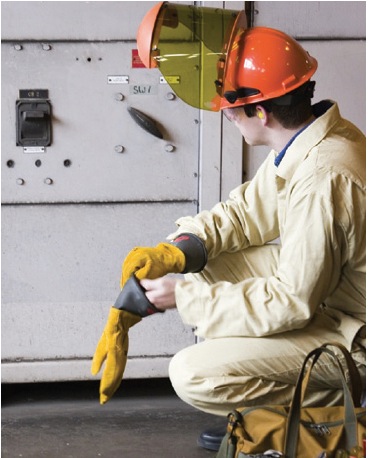
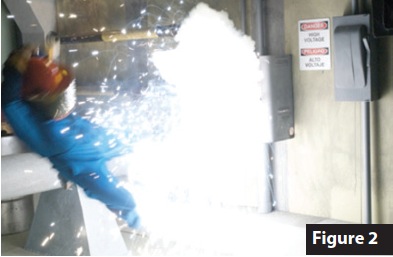
Equipment and systems that serve to mitigate arc flash hazards are examples of engineering control measures described generically in occupational safety management systems standards, such as ISO 14001 Environmental Management Systems, OHSAS 18001 Occupational Safety and Health Management Standard, ILO Guidelines for Occupational Safety and Health Management Systems, ANSI Z10 Occupational Health and Safety Management Systems, and CSA Z1000 Occupational Health and Safety Management. These standards are well harmonized on the comprehensive hazard control measures in Figure 3. In addition, they are harmonized in how these equally important measures are ranked in descending order of relative effectiveness. The top three measures align with maintenance and reliability concepts of re-engineering systems and equipment to eliminate defects and causes of failure. These control measures establish the inherent safety by design performance of the electrical system.
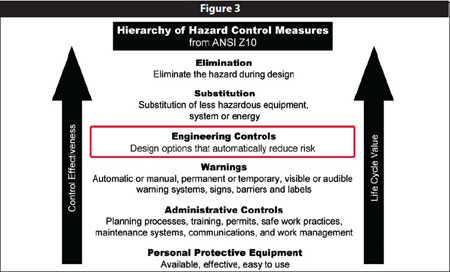
The third measure, engineering controls, includes hardware, equipment and systems whose designed intent is to prevent or limit exposure to a known hazard. In addition to the functional performance of circuit protective devices that protect people from arc flash and blast during fault conditions, other examples of engineering controls commonly applied to safeguard people from shock and/or arc flash include: equipment enclosure covers and access panels that serve to prevent contact with energized bare parts during normal operations; grounding and bonding equipment and hardware that prevent electrical shock, enable operation of protective devices during ground faults, prevent arcing in fault return paths (of particular concern in flammable and explosive environments) and prevent the presence of hazardous voltage on cabinets, enclosures, and structures during normal operation; and ground fault circuit interrupters that guard against fatal electric shock. Examples of engineering controls for electrical hazards are listed in Figure 4.
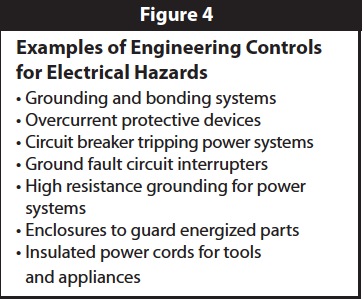
Engineering controls function automatically to perform their function. A major limitation of engineering controls is they can be rendered inoperative due to improper installation, shortcomings in commissioning or functional testing, or maintenance deficiencies. Unfortunately most engineering controls for electrical hazards fail unsafe, with no warning that functionality has been compromised. A hidden failure can go undetected until an injury occurs.
Applying RCM includes identifying critical equipment in its operating context (i.e., safety, uptime, etc.), understanding the consequences of failure, establishing goals, setting priorities, and allocating limited resources to achieve maintenance goals. Examples of proven reliability management tools include Failure Mode Effect.
Analysis, Pareto analysis, and other statistical tools; however, these methods by themselves may not identify electrical equipment critical to electrical safety. The first step in identifying the operating context is to identify the hardware, equipment, and systems comprising engineering control measures for electrical hazards.
Some examples have been discussed in this article; however, there may be others unique to a specific installation or facility. Not all electrical equipment failure has a direct impact on personnel exposure to shock or arc flash injury. A motor or feeder cable failure may have significant impact on production and uptime, but little impact on safety. On the other hand a hidden failure integral to arc flash protection has a very significant impact on safety.
Three resources that address the application of RCM to electrical equipment include these documents available from the National Fire Protection Association (NFPA) and the Institute of Electrical and Electronics Engineers (IEEE):
- NFPA 70B-2010 Recommended Practice for Electrical Equipment Maintenance
- IEEE 902-1998 Guide for Maintenance Operation and Safety of Industrial and Commercial Power Systems
- IEEE 3007.2-2010 Recommended Practice for the Maintenance of Industrial and Commercial Power Systems (Note: IEEE 902 will be discontinued in the near future and replaced with this and two other new standards, IEEE 3007.1 Recommended Practice for Operation of Industrial and Commercial Power Systems, and IEEE 3007.3 Recommended Practice for Electrical Safety of Industrial and Commercial Power Systems.) This new standard significantly expands the treatment of RCM found in IEEE 902.
Reliability and maintenance management systems involve the application of tools to assess and prioritize the application of limited resources to maximize benefits to the business. Key metrics generally include operations uptime, meantime between failure of critical equipment, ratio of planned and scheduled maintenance vs. emergency breakdown maintenance, quality of predictive and preventive maintenance programs, and workforce skills and knowledge in critical maintenance competencies.
A challenge to any organization pursuing excellence in electrical safety and in reliability and maintenance is the integration of the means to achieve these objectives. It will likely be helpful to engage a multidiscipline team, including electrical experts, safety professionals, and reliability experts. Each of these specialties brings a unique perspective when analyzing the reliability performance of electrical equipment and hardware that serve a critical safety function. Safety professionals are generally expert in safety management systems but not in the details of electrical safety.
Electrical professionals may be knowledgeable in electrical technology and how things work, but not expert in safety management systems and maintenance and reliability systems. Maintenance and reliability experts are skilled in assessing functional criticality but may not be familiar with the details of safety management or electrical systems. Senior and middle managers may not be expert in either of these competencies, but hold the keys to financial and human resources to solve and manage issues of importance to the organization. Collectively, their skills, knowledge, and responsibilities can create an extraordinary collaboration and synergy to assess and improve both the electrical safety program and electrical systems uptime. This collaborative team could begin by addressing these questions:
- Is the visibility of electrical systems in the reliability and maintenance program in alignment with the organization’s dependence on uptime and reliability of critical electrical energy and control systems?
- Does the reliability and maintenance program involve participation of electrical experts familiar with critical electrical systems in proportion to the organization’s dependency on the uptime and reliability of these electrical systems?
- How familiar are you with ANSI Z10 Occupational Health and Safety Management Systems, or CSA Z1000 Occupational Health and Safety Management, or other globally recognized safety management systems standards?
- How do these standards relate to the reliability and maintenance management systems for your organization?
- What role does your reliability and maintenance program currently play in your electrical safety program?
- What reliability do you expect for equipment critical to personnel safety? Is this different than reliability objectives for manufacturing or services uptime?
- How would you rate the collaboration and synergy among safety professionals, maintenance professionals, key members of management, and the electrical experts with respect to driving improvement in the electrical safety and the reliability and maintenance programs in your organization?
Discussion of these questions and tangential topics likely to ensue can help an organization optimize the application of RCM to equipment critical to electrical safety.
In conducting the critical analysis described in this article, an organization can develop a better understanding of how managing its electrical safety program closely coupled with its reliability and maintenance program will drive benefits across a broad set of business performance objectives. The benefits span improved energy utilization, improved on-time delivery, fewer environmental releases, optimum employee safety, improved raw material utilization, improved first pass yield, and increased operations uptime.

H. Landis “Lanny” Floyd
H. Landis “Lanny” Floyd has been with DuPont since 1973. For the past 25 years, his responsibilities have largely focused on electrical safety in the construction, operation and maintenance of DuPont facilities worldwide. He is currently Principal Consultant, Electrical Safety & Technology. He has authored or co-authored more than 50 published papers and articles on electrical safety. www.DuPont.com
Related Articles

All About Eye Protection

Arc Flash/Arc Blast Review with Safety Suggestions for Design & Maintenance
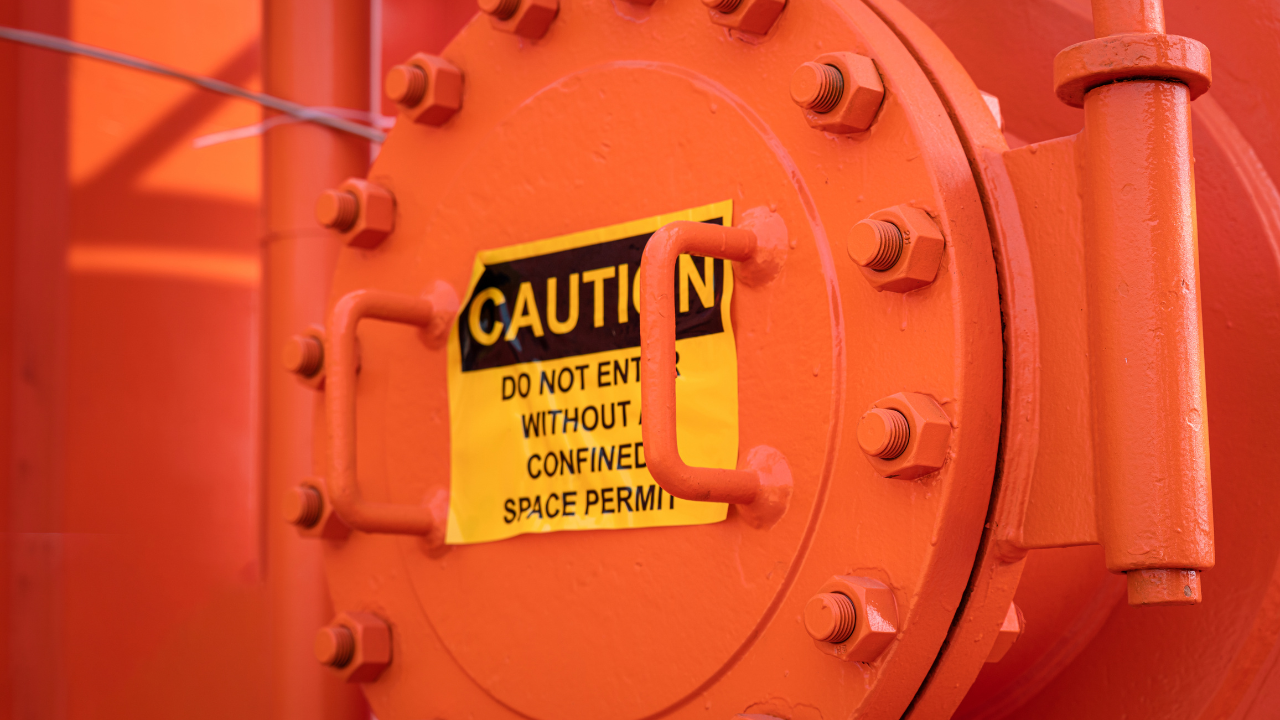
CSA Launches First Confined Spaces Standard in Canada

Do You Need NFPA 70E?
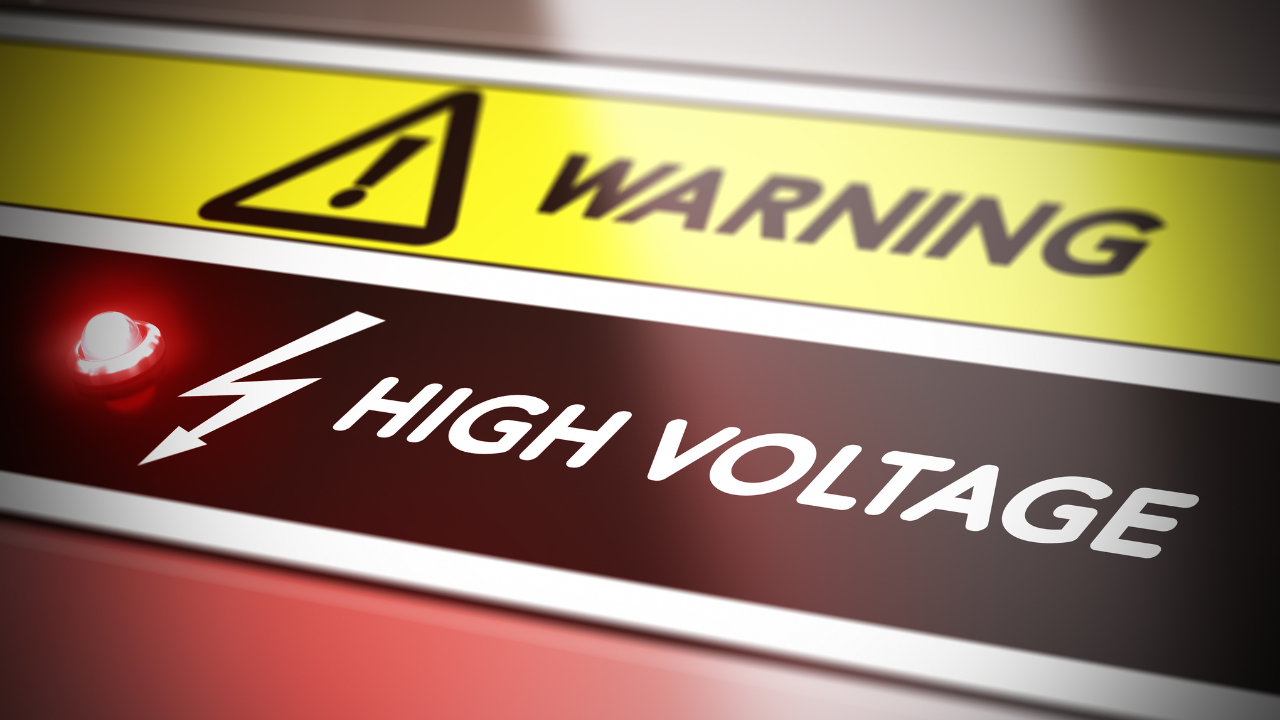
Electrical Hazards

Eye Injuries are a Serious Threat to American Workers




